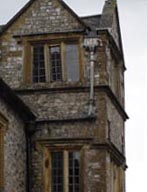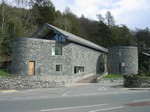|
|
ENGLISH STONE FORUM |
|
.
|
Home
> Issues > Building stone industry in Britain
1
| 2 | 3&4
| 5 | 6
| 7 | 8
| 9 | 10
| 11
|
|
|
11.
Cretaceous building stone resources
The Lower and Upper Cretaceous rocks of south eastern England have never yielded building limestone as prolifically as did the Jurassic successions, but they do contain a number of stones which in the past supported active local industries. Lower Cretaceous
The Paludina Marble (aka Bethersden, Sussex or Petworth marbles) was extensively exploited for building and decorative stone in the Weald area (Topley 1875; Worssam & Tatton-Brown 1993). The 'marble' is a hard, fossiliferous freshwater limestone which could be quarried in blocks up to 3 feet in thickness in some places (Arnold 1896). The numerous freshwater gastropods present (Viviparus sussexiensis) give it its characteristic coarsely mottled appearance when polished. The stone was widely used for decorative effect in churches in Sussex and Kent. The more siliceous nature of the Reigate Stone made it ideally suited for fire-resistant hearthstones and oven linings and the stone was extensively mined for this purpose but was also used for local building over several centuries (Sowan 1975). The most widely exploited of these Lower Cretaceous stones is the Kentish Ragstone, a hybrid mix of quartz sand and limestone which, despite its fairly intractable nature, once formed the basis of a major quarrying industry in the Maidstone area of Kent. Few older stone buildings in Kent or London are without some Kentish Ragstone in their fabric. A particular feature of some of the limestones and sandstones from the Lower Cretaceous is the presence of the vivid green mineral glauconite for example, Fovant and Hurdcott stones. Its presence can impart a distinctive green coloration to some of the rocks. Upper Cretaceous
Chalk from Totternhoe was widely used for intricate internal decorative carving as in Peterborough Cathedral and the walling of the great abbey and house at Wobum. The Burwell Stone was also used for intricate carved work, as in the Lady Chapel at Ely Cathedral. The Chalk of the Beer Quarries has been exploited since Roman times, it is a hard variety which has been widely used for both external and internal stone work at Exeter Cathedral and in numerous church windows throughout the south-west. |

Knapped flint wall
|
The
Upper Cretaceous chalk successions are also the principal source of another
important building stone of past times, the extremely hard and durable,
siliceous black white or grey flints. They provided the basic walling material
for many buildings of the south east of England where freestones are generally
in short supply. Flints are found as irregularly shaped nodular bands throughout
the Middle and Upper Chalk successions of eastern England. They were widely
used from Roman times as rubble walling, embedded in thick lime mortars
(e.g. St. Albans Cathedral). In later periods the flints were precisely
dressed or squared to form intricately patterned block-work within wall
fabrics (Mason 1978; Hart 2002). Brandon in Suffolk was a major centre
for the shaping or knapping of flints for building and other purposes.
Tertiary building stone resources
|
| Quaternary
building stone resources
Unlikely as it first seems, in view of the unconsolidated nature of the British Quaternary succession, the period has also yield a considerable amount of building stone. The stone in question is the freshwater limestone deposit known as tufa. Tufa (or travertine) is a distinctive building stone with a limited local distribution in some limestone areas. It is most commonly formed by precipitation of calcium carbonate around springs discharging and degassing from limestone successions (Pentecost 1993). The Carboniferous, Middle Jurassic and Cretaceous limestone and chalky limestone outcrops were once important sources of such tufa deposits. Dursley Tufa was used extensively at Berkeley Castle for example. Although originally quite common in many of the limestone areas around Britain the deposits are now largely worked out and the stone is no longer available in quantity. As a building material it has a long history. It was particularly favoured by the Romans, for example in Chesters Fort on Hadrian's Wall and its use has been recorded in other Roman structures. Tufa was also much prized by Norman (e.g. St Augustine's Abbey, Canterbury) and later medieval builders. It is easily worked, strong, highly porous and therefore light. These properties made it a suitable choice for vaulting masonry in churches and cathedrals. Tufa was also much in demand in Victorian times for constructing show-piece garden 'grottos'. |
|

The Jerwood Centre Cumbria. Burlington slate |
Today's
building limestone industry
Today's building limestone industry is still thriving, both for new-build and conservation work, but it has contracted considerably. Building limestone production is still centred principally on the Jurassic outcrops around Bath, in Somerset, the Cotswolds, Wiltshire (Chilmark), Oxfordshire (Hornton), Dorset (Portland & Purbeck) and Lincolnshire (Ancaster, Clipsham, Ketton, Stamford) and Leicestershire. Present state of the building
stone industry
The dimension stone industry has to continue its efforts to educate and inform the public of the differences in scale of these two ventures if we are to continue to produce dimension stone, not only to conserve our existing historic stone structures but also to build new stone housing, thus complementing and continuing a vernacular building tradition which has developed over several centuries. These traditional skills have provided us with some of our most picturesque villages and towns and provided many parts of Britain with a unique regional architectural identity. As far as Britain's building stone industry is concerned the catch phrase should be 'variety is the spice of life' we need to encourage usage of old and new stone in our buildings and not allow this rich heritage in stone to dwindle away. |
/Recommended
reading
Woodward, H.B. 1894. The Jurassic Rocks of Britain. Memoir of the Geological Survey of Great Britain. |
|
| 1 | 2 | 3&4 | 5 | 6 | 7 | 8 | 9 | 10 | 11 | |
| . |
|